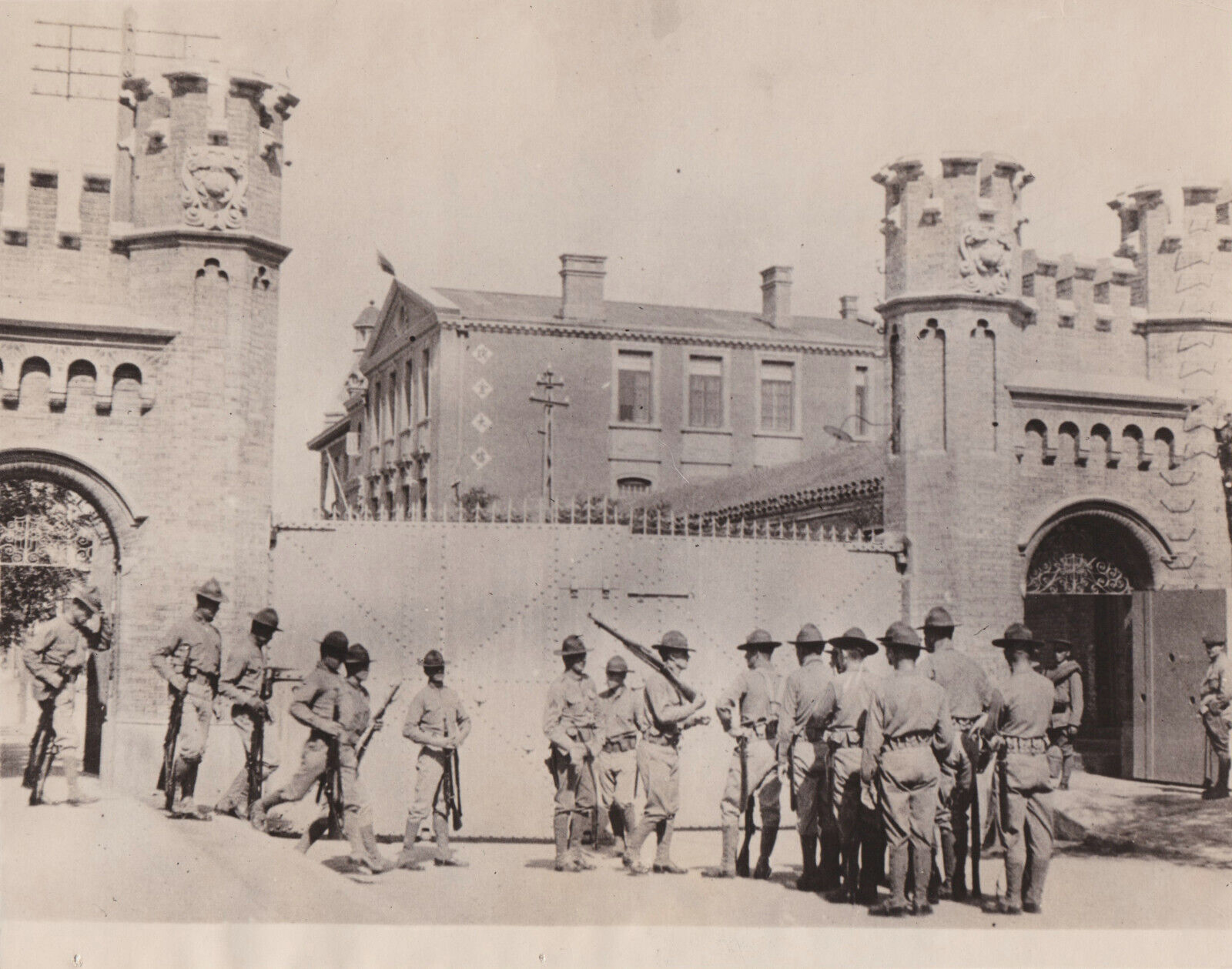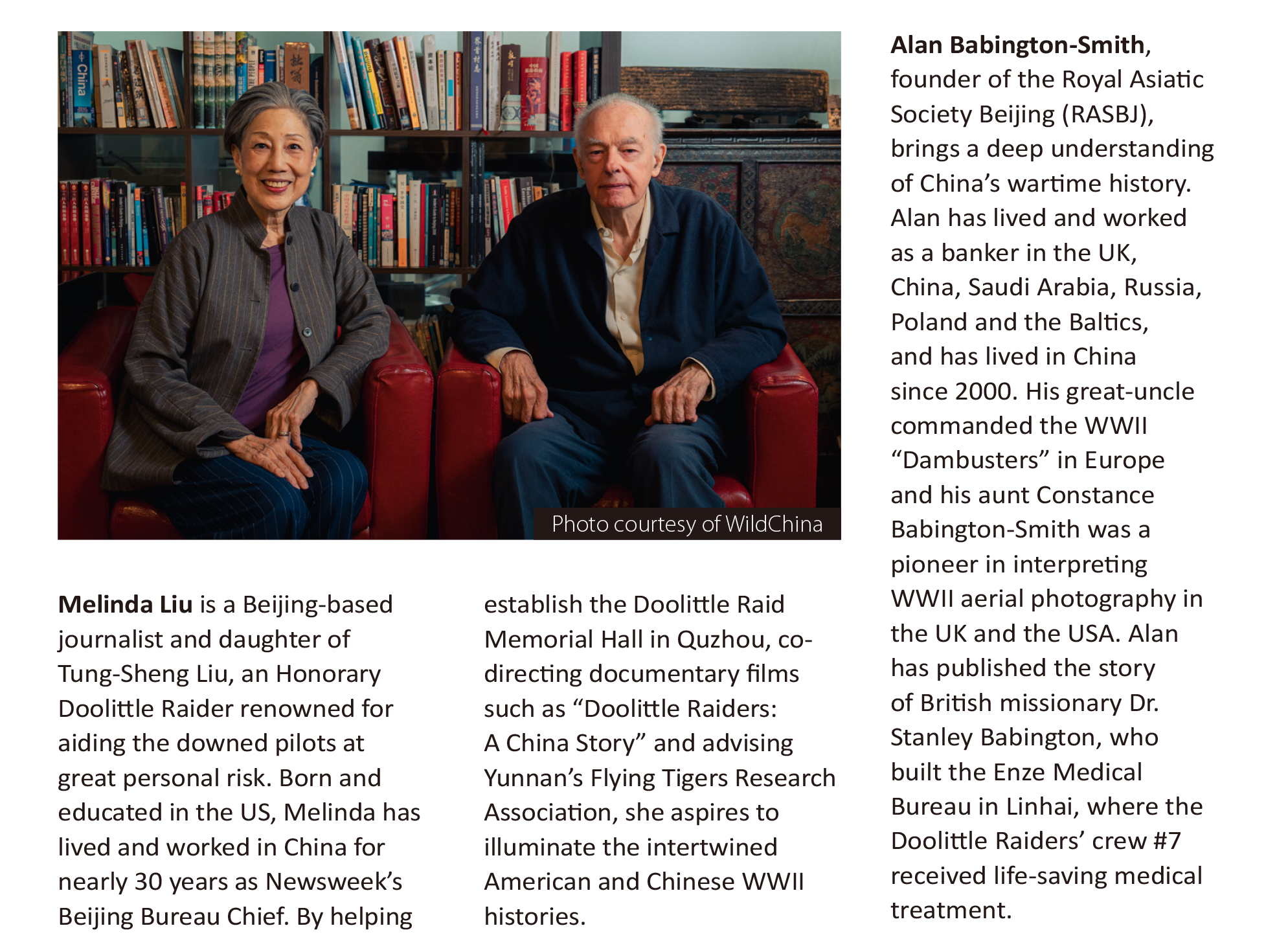WildChina Journeys Through History to Commemorate the 80th Anniversary of WWII’s End
Foreword by WildChina Co-founder Albert Ng
As the world marks the 80th anniversary of the end of World War II, WildChina is honoring this historic milestone by retracing the past. In partnership with the Royal Asiatic Society Beijing (RASBJ), WildChina is launching a series of expert-led journeys exploring China’s pivotal role in WWII. Through the stories of the Doolittle Raiders, the Flying Tigers, and local communities, these immersive experiences offer a deeper understanding of the enduring US-China wartime alliance. Join the AmCham China Quarterly as we reflect on history, uncover untold stories, and bridge cultures through the power of travel with WildChina Co-founder Albert Ng, veteran journalist Melinda Liu, and RASBJ Founder Alan Babington-Smith.

Above:
US Marines assembled in front of the American Consulate in Beijing on April 7, 1927, preparing to protect foreign residents (from the collection of Zou Dehuai)
Photo courtesy of WildChina
2025 marks two significant milestones: the 80th anniversary of WWII’s end in the Pacific Theater and WildChina’s 25th anniversary. Both celebrate enduring connections between people and nations. The WWII anniversary honors the shared history of Chinese and Americans fighting for a common cause, while WildChina’s anniversary reflects our commitment to fostering people-to-people connections.
For 25 years, WildChina has helped adoptees find their roots, brought tens of thousands of students to experience China’s diversity, and guided businesses on the ground, taking them to factories, innovation hubs, and rural communities to witness China’s transformation firsthand. Behind the geopolitics, we see shared humanity, friendship, and deep connections.
To commemorate the 80th anniversary of WWII, WildChina is proud to partner with the Royal Asiatic Society Beijing (RASBJ) to present a curated series of expert-led journeys titled Allied Victory: Western Aviators and the WWII Battlefields of China. These programs will offer an immersive and reflective exploration of the pivotal events and collaborative efforts that ultimately led to the Allied victory. By preserving the legacies of the Doolittle Raiders and the Flying Tigers, these trips highlight the enduring US-China partnership against fascism during WWII.
At the heart of these journeys are two esteemed historians, Melinda Liu and Alan Babington-Smith, who bring personal and professional insights into this crucial chapter of history.
WildChina’s interest in WWII history in China was sparked by personal stories from individuals like Melinda and Alan. Their accounts of Chinese and Americans standing together in wartime underscore the power of cross-cultural solidarity—a theme that remains deeply relevant today. At WildChina, our philosophy is to connect people and bridge cultures through experiential travel. These WWII journeys offer a rare opportunity to retrace oft-forgotten footsteps and engage with history in a deeply immersive way.
With extensive expertise in Western China, particularly Yunnan, WildChina brings a unique perspective to these WWII journeys. This region was a critical theater during the war and holds personal historical significance. Our founder, Mei Zhang, grew up in Yunnan, hearing firsthand stories from her relatives about American soldiers in the region.
As we reflect on these milestone anniversaries, we are reminded of the importance of cooperation and cultural exchange, particularly in today’s complex US-China landscape. WildChina is committed to going beyond the headlines, creating immersive experiences that foster genuine connections between people. Whether it’s retracing historical footsteps, exploring China’s ancient trade routes, or engaging with local communities, our goal remains the same: to deepen cross-cultural understanding through transformative travel.
Now, as we look ahead, Melinda Liu and Alan Babington-Smith share their insights on WWII’s lasting impact and why these stories matter today.
Uncovering WWII’s Hidden Stories: A Conversation with Melinda Liu & Alan Babington-Smith

How did your personal connection to WWII history in China influence your work in historical preservation and storytelling?
Melinda Liu: I’ve heard stories about Western aviators in WWII China since I was a child. My father, Tung-Sheng Liu was a graduate in aeronautical engineering from Tsinghua University. In April 1942, he found himself on the east coast of China near Ningbo, waiting to be smuggled out of Japanese-controlled areas into western China, which was dominated by the Chinese Nationalist military. One night, some locals came to the small hotel where he was staying and asked, “Do you speak English?” It was an odd question, but he answered, “Yes, I do because some of my university course material was in English.” The locals asked him to get his suitcase and follow them. He thought they would bring him to the people smugglers who would lead him to Western China. But instead, they brought him to a room and led him inside. There were five disheveled Western men in muddy uniforms; no one could understand what they were saying. My father had been brought there to translate. He quickly ascertained they were crew #2 of the Doolittle Raiders, which had just finished bombing Japanese cities. Realizing they were Americans – and therefore allies with the Chinese – the locals began treating them as guests. My father decided to translate for them and help guide them to safety. Japanese soldiers were not far away, searching for Doolittle Raiders who had bailed out from their aircraft. In the following days, my father stayed with Crew #2 and subsequently met and helped many other Raiders gather in the city of Quzhou in western Zhejiang. Eventually, they were transported to the wartime capital of Chungking (Chongqing). After the war, my father went to the USA for further studies and became reunited with the Raiders there; he eventually was hired as a civilian aeronautical engineer at Wright-Patterson Air Force Base. Gen. Doolittle organized annual reunions, so I grew up hearing the stories of these legendary aviators and becoming acquainted with their families.
As a journalist, I know the importance of firsthand accounts and primary sources. Even though I’d heard many stories when I was a child, I was an adult before I fully appreciated the importance of hearing such narratives from people who were still alive and able to recount their firsthand experiences. I regret not talking with my father more about his wartime experiences with the Raiders and while working for the China National Aviation Corporation. I know children and grandchildren who have many questions about the Chinese who helped their fathers and grandfathers. It’s important for both sides to acknowledge this shared history. I’ve helped descendants of Doolittle Raiders visit China – either in small groups or as part of a 20-some delegation in 2018. I’ve also helped the Chinese establish museums, memorial halls, and monuments to Western aviators of WWII China. Now, 80 years after the Raid, very few of the WWII generation are left. But there are still ways to tell their stories and help these narratives live on.
Could you tell us about your founding of RASBJ and how it became a reservoir of knowledge about WWII China?
Alan Babington-Smith: RASBJ was set up 10 years ago to introduce Chinese history and culture to a mainly expat audience. We have organized several events, including movie screenings about unusual aspects of World War II. RASBJ’s experience has highlighted to me the importance of personal records and accounts of events at an individual level – that is, below the level that history books normally cover. For example, in terms of my family’s history in World War II, I regret that we have only the scantiest records of service from my father and his siblings or my grandfather, who did notable things.
China played a pivotal role in supporting Western aviators during WWII, yet many of these stories remain underappreciated. What are some overlooked moments from this period of history that you hope to highlight?
Melinda Liu: There are many reasons why the Chinese side of the story has been overlooked by Western audiences, and even by many Chinese. The fighting in Asia and Europe seemed far away to many Americans before Japan’s surprise attack on Pearl Harbor in December 1941. After this traumatic event, many headlines recounted the drama of the US and other Allied defeats in the Pacific, such as the fall of Hong Kong, Manila, Malaya, and so on. Positive stories often focused on Allied forces’ successes, such as the daring April 18, 1942 Doolittle Raid on Japanese cities, intended as Washington’s revenge for Pearl Harbor. Boosting US morale and helping set the stage for later U.S. success in the Battle of Midway, this Raid was the topic of a book Thirty Seconds over Tokyo, by pilot Ted Lawson, which was made into an Oscar-winning Hollywood film. However, at the time, not much was known about the ordinary Chinese who had risked their lives to help rescue the Doolittle Raiders.
Many Chinese rescuers risked their lives to help the Raiders who had bailed out from their aircraft in Eastern China and were pursued by Japanese troops. Shortly afterwards, Japan launched two retaliation campaigns in the areas where the Raiders landed, killing as many as 250,000 Chinese. Some of these stories took place in relatively remote areas during chaotic times, and events were not always explained clearly in international media. This is why many Chinese call all Western aviators who fought in WWII “Flying Tigers,” even though the Flying Tigers were a specific group and were quite separate from the Doolittle Raiders. Another key group of aviators were the pilots who flew the so-called ‘Hump’ transport route, carrying supplies from British India to Western China. The more we understand about who they were and what they did, the better we can grasp the shared history between the Americans and Chinese.
Why is this year significant not only for China but also for other countries involved, such as the US and the UK?
Alan Babington-Smith: Every anniversary is important to remind people of the horrors of war. The 80th anniversary is particularly poignant because it is almost certainly the last, when people who took part in World War II are still alive. In the war in Asia, the US quite rightly claims pride of place but other nationalities, particularly the British, contributed most notably to Western China. Britain was both defending India and helping China. The logistics support operation colloquially known as The Hump, was the most striking of these supports. This involved ferrying cargo from India over the Himalayas to Yunnan. This was an exceptionally hazardous operation. It is reckoned that over 600 pilots and 1000 planes were lost — almost a third of the total involved. It was so hazardous that the flight route became known as “the Aluminum Trail” because of the wreckage. Weather was a principal hazard — planes were often flying above their operational ceiling, except when they were dashed down by ice storms or thunderstorms. They had very limited navigational tools, and no oxygen. All pilots were taught to defend themselves and if necessary, kill themselves if they crashed. Without this transport network, the Chinese wartime capital of Chongqing (Chungking) would have been even more starved of crucial supplies.
How do you envision these WWII journeys could spark broader dialogue between the US and China in the business and diplomatic communities?
Melinda Liu: Broader dialogue can be one result if both sides deepen their communications and experiences with one another. Bringing Westerners to China to explore a shared history is one way to underscore common interests. When we bring friends to follow in the footsteps of American, British, and other Westerners of WWII China, the visitors immediately see and feel the deep reservoir of goodwill towards Westerners that exists among grassroots Chinese. Some of these wartime narratives unfolded in remote and rural areas where most diplomats and business executives don’t explore. By witnessing these little-known corners of Chinese society, and sharing experiences with ordinary Chinese, visitors can have a more complete perspective on China as a whole.

This article is from the AmCham China Quarterly Magazine (Issue 1, 2025). To access the entire publication for free, sign up on our member portal here.

